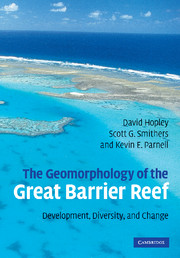Book contents
- Frontmatter
- Contents
- Preface
- Acknowledgements
- 1 Geomorphology and the Great Barrier Reef
- 2 Foundations of the Great Barrier Reef
- 3 Sea level: a primary control of long-term reef growth and geomorphological development
- 4 Oceanography, hydrodynamics, climate, and water quality as influences on reef geomorphological processes
- 5 Spatial analysis of the morphology of the reefs and islands of the Great Barrier Reef
- 6 The non-reefal areas of the continental shelf
- 7 Fringing and nearshore coral reefs
- 8 The mid-shelf reefs of the Great Barrier Reef
- 9 The coral reefs of the outer shelf of the Great Barrier Reef
- 10 Islands of the Great Barrier Reef
- 11 The accumulation of the Holocene veneer to the Great Barrier Reef
- 12 The Holocene evolution of the Great Barrier Reef province
- 13 Geomorphology's contribution to the understanding and resolution of environmental problems of the Great Barrier Reef
- References
- Geographic index
- Subject index
5 - Spatial analysis of the morphology of the reefs and islands of the Great Barrier Reef
Published online by Cambridge University Press: 22 August 2009
- Frontmatter
- Contents
- Preface
- Acknowledgements
- 1 Geomorphology and the Great Barrier Reef
- 2 Foundations of the Great Barrier Reef
- 3 Sea level: a primary control of long-term reef growth and geomorphological development
- 4 Oceanography, hydrodynamics, climate, and water quality as influences on reef geomorphological processes
- 5 Spatial analysis of the morphology of the reefs and islands of the Great Barrier Reef
- 6 The non-reefal areas of the continental shelf
- 7 Fringing and nearshore coral reefs
- 8 The mid-shelf reefs of the Great Barrier Reef
- 9 The coral reefs of the outer shelf of the Great Barrier Reef
- 10 Islands of the Great Barrier Reef
- 11 The accumulation of the Holocene veneer to the Great Barrier Reef
- 12 The Holocene evolution of the Great Barrier Reef province
- 13 Geomorphology's contribution to the understanding and resolution of environmental problems of the Great Barrier Reef
- References
- Geographic index
- Subject index
Summary
Introduction
The character and geomorphic diversity of the Great Barrier Reef (GBR) is still being discovered. Although described as a geomorphic system for well over a century, with small sections being studied in detail since the 1920s following the establishment of the Great Barrier Reef Committee and the Royal Society expedition in 1928–29 (see Chapter 1), it is only since the 1970s that LANDSAT imagery combined with extensive but incomplete aerial photography has enabled the extent and detail of the GBR to be described. Until a comprehensive bathymetric survey occurred in the 1980s, large areas of reef remained uncharted, particularly in the northern section where reefs are densest and away from shipping channels, and in the southern GBR, where the reef is complex and a considerable distance offshore. Since that time, the availability of spatial data derived using various remote sensing methodologies, and made accessible using Geographic Information System (GIS) technology, has increased and developed to the point where basic statistics and zoning information are accessible via Internet-based interactive GIS (Great Barrier Reef Marine Park Authority, 2004). However, a combination of supervised and unsupervised interpretation of satellite imagery has resulted in problems being introduced for morphological analysis with truthing either by examination of high-resolution imagery or ground survey not keeping pace with data acquisition.
Remote sensing and the Great Barrier Reef
Although some aerial photograph images have been available since the 1920s (Bowen and Bowen, 2002), comprehensive coverage of the GBR was not available until satellite imagery became available.
- Type
- Chapter
- Information
- The Geomorphology of the Great Barrier ReefDevelopment, Diversity and Change, pp. 138 - 165Publisher: Cambridge University PressPrint publication year: 2007



